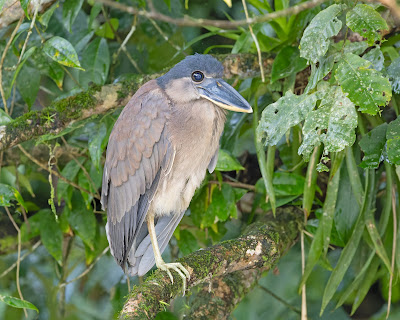Well, it's been a while. We got busy with another trip, and are about to leave once again, but I thought I'd try to get another day of our Costa Rica trip out before we leave!!
Wednesday, January 24, 2024
This morning we had another boat trip, this time to Medio Queso. We left the lodge at 5:30 in order to arrive at the dock at 6:30. We set out once again with Captain Chambito, but this time he was not driving the boat, but acting as a second guide. Since we were on a different river, he had made arrangements with another boat captain to take us out. He is a great spotter and knows the area well, so we were glad to have him along.
Before we even boarded the boat we saw a Roadside Hawk perched on a post near the parking area. A good omen!
Medio Queso is very different than our previous locations for boat rides as it is a huge marsh with very few trees. Just thousands of acres of flooded grasses, and full of birds.
 |
| Medio Queso |
Our first big find was a Pinnated Bittern spotted by Teri. This was a life bird for us, and it turned out that we would see several before the ride was over. They are similar to our American Bittern and just as well camouflaged.
We had a flyover by our first Magnificent Frigatebird of the trip and also saw Black-collared Hawk, Snail Kite, and Sungrebe.
One of our targets was the Yellow-breasted Crake, a very small and secretive rail that likes to hide in medium height grasses. The captains knew of three different areas to try. At the first area Chambito saw one just as we approached the grassy edge, but it ran off and we didn’t get to see it. At the second location there was no bird, but the third location was the charm. There were two Yellow-breasted Crakes there. One immediately walked off into the grass, never to be seen again, but the other was cooperative and came toward the call being played. We got great looks and good pictures of this rare bird, which was another life bird for us.
At one point we passed near the road where we had parked. It appeared to dead end at the water, but we got to watch a motorbike cross to the other side on a hand-pulled ferry. It looked big enough for a car, but I don't know that I'd be brave enough to try it!
We saw many other nice birds on the trip, including our best ever looks at a Mangrove Cuckoo, and a White-Tailed Kite.
Back on the dock our final bird for the trip was a Lesser Yellow-headed Vulture, which is very similar to our Turkey Vulture but with bare pale yellow skin on the face instead of red.
On the drive back to the lodge we passed a small wetland with hundreds of wading birds. There was a single Jabiru in the bunch which was huge compared to even the normally large-looking Wood Storks.
We returned to the lodge at 11:00 and had lunch at 11:30. The food at this lodge was very nice, and I discovered that their Mango Juice was served as a slush with a lot of finely ground ice. What a nice treat in this warm, humid area.
After relaxing in our air-conditioned room until 2:45 we headed out to do some roadside birding. We stopped first in the location where we’d seen the Pacific Screech Owl the previous night. It was next to a small patch of forest, but wasn’t productive. So we headed off to a different nearby road where we had more luck. A Crane Hawk perched in a tree and then used its unusually long legs to reach into a nest hole. It didn’t find anything there to eat and flew away. It was interesting to see this hunting behavior.
As we walked alongside the road we saw a nice variety of birds, including Cinnamon and White-winged Becards, Olive-throated Parakeets, and a few Crimson-fronted Parakeets which are much less common in this part of Costa Rica. We ended our evening looking over a lagoon while hundreds of waders, ibis, and cormorants flew in and landed for the night.













%2001-24-2024.jpg)


%2001-24-2024.jpg)
%2001-24-2024.jpg)
%2001-24-2024.jpg)
%2001-24-2024.jpg)
%2001-24-2024.jpg)
%2001-24-2024.jpg)
%2001-24-2024.jpg)
%2001-24-2024.jpg)
%2001-24-2024.jpg)
%2001-24-2024.jpg)


















%2001-23-2024.jpg)
%2001-23-2024.jpg)
%2001-23-2024.jpg)
%2001-23-2024.jpg)






























